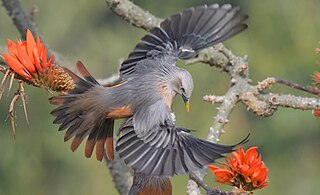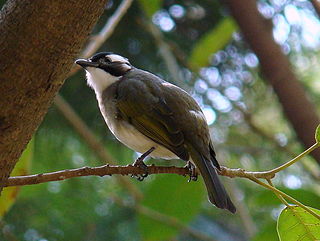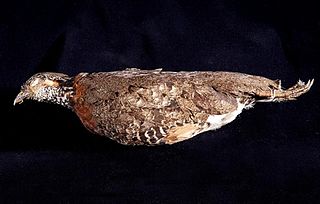
The red spurfowl is a member of the pheasant family and is endemic to India. It is a bird of forests, and is quite secretive despite its size. It has a distinctive call and is often hard to see except for a few seconds when it flushes from the undergrowth. It appears reddish and like a long-tailed partridge. The bare skin around the eye is reddish. The legs of both males and females have one or two spurs, which give them their name.

The forest wagtail is a medium-sized passerine bird in the wagtail family Motacillidae. It has a distinctive plumage that sets it apart from other wagtails and has the habit of wagging its tail sideways unlike the usual up and down movements of the other wagtail species. It is the only wagtail species that nests in trees. It is found mainly in forested habitats, breeding in the temperate parts of east Asia and wintering across tropical Asia from India to Indonesia.

The black bulbul, also known as the Himalayan black bulbul or Asian black bulbul, is a member of the bulbul family of passerine birds. It is found primarily in the Himalayas, its range stretching from India eastward to Southeast Asia. It is the type species of the genus Hypsipetes, established by Nicholas Aylward Vigors in the early 1830s. There are a number of subspecies, mostly varying in the shade of the body plumage which ranges from grey to black, and some also occur in white-headed morphs, as also suggested by its specific epithet leucocephalus, literally "white head". The legs and bill are always rich orange-red.

The brahminy starling or brahminy myna is a member of the starling family of birds. It is usually seen in pairs or small flocks in open habitats on the plains of the Indian subcontinent.

The chestnut-tailed starling, also called grey-headed starling and grey-headed myna is a member of the starling family. It is a resident or partially migratory species found in wooded habitats in India and Southeast Asia. The species name is after the distribution of a former subspecies in the Malabar region. While the chestnut-tailed starling is a winter visitor to peninsular India, the closely related resident breeding population with a white head is now treated as a full species, the Malabar starling.

The stone partridge is a bird of the New World quail family. This largely brown bird, which commonly holds its tail raised, is found in scrubland and lightly wooded habitats, often near rocks, from Kenya and Ethiopia to Gambia.

Cabot's tragopan is a pheasant found in south-east China. The common and scientific names of this large bird both commemorate the ornithologist Samuel Cabot III. Other common names include the Chinese tragopan and the yellow-bellied tragopan. The population is divided into two subspecies, of which the dominant subspecies is found in the provinces of Fujian, Jiangxi, Zhejiang, and Guangdong, and T. c. guangxiensis is confined to northeastern Guangxi and southern Hunan. The IUCN has assessed it as being a "vulnerable species".

The light-vented bulbul, also called the Chinese bulbul, is a species of bird in the bulbul family found in central and southern China, Hong Kong, Macao, northern Vietnam, southern Japan and Taiwan, with occasional records from South Korea. A common species of songbird that favors lightly wooded habitats, it can frequently be seen in towns, suburbs and urban parks within its range.

The grey francolin is a species of francolin found in the plains and drier parts of the Indian subcontinent and Iran. This species was formerly also called the grey partridge, not to be confused with the European grey partridge. They are mainly ground-living birds and are found in open cultivated lands as well as scrub forest and their local name of teetar is based on their calls, a loud and repeated Ka-tee-tar...tee-tar which is produced by one or more birds. The term teetar can also refer to other partridges and quails. During the breeding season calling males attract challengers, and decoys were used to trap these birds especially for fighting.

The rain quail or black-breasted quail is a species of quail found in the Indian Sub-continent and South-east Asia; its range including Pakistan, India, Nepal, Sri Lanka, Bangladesh, Myanmar, Thailand, Cambodia and Vietnam.

The painted sandgrouse is a medium large bird in the sandgrouse family Pteroclidae found in Bangladesh, India and Pakistan.

The common woodshrike is a species of bird found in Asia. It is now usually considered a member of the family Vangidae. It is small and ashy brown with a dark cheek patch and a broad white brow. It is found across Asia mainly in thin forest and scrub habitats where they hunt insects, often joining other insectivorous birds. The form found in Sri Lanka which was treated as a subspecies is now usually considered a separate species, the Sri Lanka woodshrike.

The chestnut-bellied partridge also known as chestnut-bellied hill-partridge or Javan hill-partridge is a small, up to 28 cm long, partridge with a rufous crown and nape, red legs, grey breast, brown wings, red facial skin, and a black mask, throat and bill. It has a rufous belly with white on the middle. The sexes are similar. The young has a whitish face and a reddish brown bill.

The Hainan partridge is a species of bird in the family Phasianidae. It is endemic to Hainan Island, China. Its natural habitats are primary evergreen forests. It is threatened by habitat loss and has been assessed as a vulnerable species.

The chestnut-necklaced partridge is a species of bird in the family Phasianidae. It is found in forests in the Malay Peninsula and Sumatra. It is threatened by habitat loss and trapping. The International Union for Conservation of Nature (IUCN) has assessed it as vulnerable.

The Taiwan partridge or Taiwan hill partridge is a species of bird in the family Phasianidae. It is found only in Taiwan, and its natural habitat is broadleaf forests. It is threatened by habitat loss, but at present is categorised by the International Union for Conservation of Nature (IUCN) as being of least concern.

The rufous-throated partridge is a species of bird in the family Phasianidae. It is found in montane forests in India and Southeast Asia. The International Union for Conservation of Nature (IUCN) has assessed it as a least-concern species.

The marbled wood quail, also known as the Amazonian wood quail, is a species of bird in the New World quail family. It has an extensive distribution in Central America and the northern part of South America. Its natural habitat is subtropical or tropical moist lowland forests.

Perdicinae is a polyphyletic former subfamily of birds in the pheasant family, Phasianidae, regrouping the partridges, Old World quails, and francolins. Although this subfamily was considered monophyletic and separated from the pheasants, tragopans, junglefowls, and peafowls (Phasianinae) till the early 1990s, molecular phylogenies have shown that these two subfamilies actually constitute only one lineage. For example, some partridges are more closely affiliated to pheasants, whereas Old World quails and partridges from the Alectoris genus are closer to junglefowls. Due to this, the subfamily Perdicinae is no longer recognized by the International Ornithological Congress, with the species being split among 3 subfamilies.




















